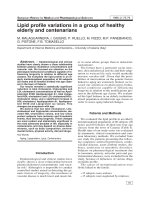- Trang chủ >>
- Đại cương >>
- Kinh tế vĩ mô
digital communities in a networked society e-commerce e-business and e-government
Bạn đang xem bản rút gọn của tài liệu. Xem và tải ngay bản đầy đủ của tài liệu tại đây (2.25 MB, 259 trang )
Digital Data Integrity
The Evolution from Passive Protection
to Active Management
DAVID B. LITTLE
SKIP FARMER
OUSSAMA EL- HILALI
Symantec Corporation, USA
Digital Data Integrity
Digital Data Integrity
The Evolution from Passive Protection
to Active Management
DAVID B. LITTLE
SKIP FARMER
OUSSAMA EL- HILALI
Symantec Corporation, USA
ß 2007 Symantec Corporation (formerly VERITAS Software Corporation).
All rights reserved. VERITAS and all other VERITAS product names are trademarks
or registered trademarks of Symantec Corporation or its affiliates in the U.S.
and other countries. Other names may be trademarks of their respective owners.
Published in 2007 by John Wiley & Sons Ltd, The Atrium, Southern Gate, Chichester,
West Sussex PO19 8SQ, England
Email (for orders and customer service enquiries):
Visit our Home Page on www.wiley.com
All Rights Reserved. No part of this publication may be reproduced, stored in a retrieval system
or transmitted in any form or by any means, electronic, mechanical, photocopying, recording,
scanning or otherwise, except under the terms of the Copyright, Designs and Patents Act 1988
or under the terms of a licence issued by the Copyright Licensing Agency Ltd, 90 Tottenham
Court Road, London W1T 4LP, UK, without the permission in writing of the Publisher.
Requests to the Publishershould be addressed to the Permissions Department, John Wiley & Sons
Ltd, The Atrium, Southern Gate, Chichester, West Sussex PO19 8SQ, England, or emailed to
, or faxed to (þ44) 1243 770571.
This publication is designed to provide accurate and authoritative information in regard to
the subject matter covered. It is sold on the understanding that the Publisher is not engaged in
rendering professional services. If professional advice or other expert assistance is required,
the services of a competent professional should be sought.
Other Wiley Editorial Offices
John Wiley & Sons Inc., 111 River Street, Hoboken, NJ 07030, USA
Jossey-Bass, 989 Market Street, San Francisco, CA 94103-1741, USA
Wiley-VCH Verlag GmbH, Boschstr. 12, D-69469 Weinheim, Germany
John Wiley & Sons Australia Ltd, 42 McDougall Street, Milton, Queensland 4064, Australia
John Wiley & Sons (Asia) Pte Ltd, 2 Clementi Loop #02-01, Jin Xing Distripark, Singapore
129809
John Wiley & Sons Canada Ltd, 6045 Freemont Blvd, Mississauga, ONT, L5R 4J3, Canada
Anniversary Logo Design: Richard J. Pacifico
British Library Cataloguing in Publication Data
A catalogue record for this book is available from the British Library
ISBN 978-0-470-01827-9 (HB)
Typeset in 10/12 pt Sabon by Thomson Digital
Printed and bound in Great Britain by TJ International Ltd, Padstow, Cornwall
This book is printed on acid-free paper responsibly manufactured from sustainable forestry
in which at least two trees are planted for each one used for paper production.
Contents
Acknowledgements xi
Introduction xiii
1. An Introduction to Data Protection Today 1
1.1 Introduction 1
1.2 Traditional Backup and Recovery 1
1.3 Hierarchical Storage Migration (HSM) 5
1.4 Disaster Recovery 6
1.5 Vaulting 7
1.5.1 Offsiting Original Backup 10
1.5.2 Create Multiple Copies of the Backup 10
1.5.3 Duplicate the Original Backup 10
1.6 Encryption 11
1.6.1 Client Side Encryption 11
1.6.2 Media Server Encryption 12
1.6.3 Encryption Appliance 12
1.7 Management and Reporting 12
1.7.1 Service Level Management 13
1.8 Summary 14
2. The Evolution 15
2.1 Introduction 15
2.2 Storage Virtualization 15
2.2.1 Why Storage Virtualization? 16
2.3 RAID 17
2.3.1 So What Does This Really Mean? 18
2.4 RAID Levels 19
2.5 What Mirroring and RAID Do Not Do 22
2.5.1 Which RAID Should I Use When? 23
2.6 Replication 24
2.6.1 Host-Based Replication 27
2.6.2 RAID System Replication 27
2.7 Standby or DR Site 28
2.8 Summary 29
3. Backup Integration 31
3.1 Introduction 31
3.2 Snapshots 31
3.2.1 Mirror 32
3.2.1.1 Mirror as an instant recovery
mechanism 32
3.2.1.2 Mirror as a backup object, either
by the application server or by a
backup server 32
3.2.1.3 Mirror resynchronization 33
3.2.2 COW Snapshot 35
3.2.3 Replication 37
3.2.4 Applications 38
3.2.5 Summary 39
4. Bare Metal Restore 41
4.1 Introduction 41
4.2 Background 41
4.2.1 Why BMR? 42
4.2.2 Why Has This Taken So Long? 43
4.3 The Evolution of BMR Capabilities 44
4.3.1 The Manual Reinstall-and-Restore Method 45
4.3.1.1 Limitations of the manual reinstall-
and-restore method 45
4.3.2 Operating System Provided Recovery
Solutions 48
4.3.2.1 Limitations of operating system
provided recovery solutions 49
4.3.3 Hybrid or Home-Grown Recovery Solutions 50
4.4 Filling the Gap – Integrated BMR 53
4.4.1 The Bar Rises 54
4.5 The Problem of Dissimilar Disk Recovery 55
4.5.1 Approach 1: Changing the Disk and Volume
Configuration Information 55
vi CONTENTS
4.5.2 Approach 2: Adjusting the Volumes
and File Systems During Recovery 56
4.6 The Problem of Automating Disk Mapping 56
4.7 The Problem of Dissimilar System Recovery 58
4.7.1 Windows Dissimilar System Restore Issues 59
4.7.2 UNIX Dissimilar System Restore Issues 60
4.8 The Current State of Integrated BMR 61
4.9 The Future of BMR 62
4.9.1 Enterprise Data Protection Server
Self-Restore 62
4.9.2 Automated Dissimilar Disk Restore 63
4.9.3 Automated Dissimilar System Recovery 63
4.9.4 Network Integration 64
4.10 New Capabilities and Challenges in Data
Protection and the Effect on Bare Metal Recovery 64
4.10.1 Continuous Data Protection (CDP) 64
4.10.2 Single Instance Store (SIS) 64
4.10.3 Storage Area Network (SAN) 65
4.11 Large-Scale Automated Bare Metal Recovery 65
4.12 Summary 66
5. Management 67
5.1 Introduction 67
5.2 Protecting Data Throughout Its Life Cycle 69
5.3 Architecting for Efficient Management 71
5.4 Reporting 78
5.4.1 Backup Operations Reporting 79
5.4.2 Alerting and Notification 81
5.4.3 Backup Reporting to Business Units 83
5.5 Business Unit Chargeback 86
5.5.1 Backup Service Providers 86
5.6 Conclusion 87
6. Security 89
6.1 Introduction 89
6.2 Encryption and Data Protection 90
6.2.1 Encryption Overview 90
6.2.2 Encryption and Key Management 91
6.2.3 Encryption Use in Data Protection 92
CONTENTS vii
6.3 Data Protection Application Security 94
6.3.1 Terminology 95
6.3.1.1 Authentication 95
6.3.1.2 Authorization 95
6.3.1.3 Access control 96
6.3.2 Role-Based Security 96
6.3.3 Audit Trails 97
6.3.4 Firewalls 97
6.4 Security Vulnerabilities in Data Protection Applications 98
6.4.1 Vulnerability Detection and Fix Process 99
6.4.2 Types of Vulnerabilities 100
6.5 Conclusion 101
7. New Features in Data Protection 103
7.1 Introduction 103
7.2 Synthetic Backups 104
7.3 Evolution of Synthetic Backups 106
7.4 Benefits of Synthetic Backups 106
7.5 Building a Synthetic Backup 108
7.6 Technical Considerations and Limitations 109
7.6.1 File-Based Versus Block-Based Synthetics 109
7.6.2 File Types and File Change Frequency 109
7.6.3 Media Considerations 110
7.7 Disk-Based Solutions 110
7.8 Disk to Disk 111
7.9 Disk Staging 112
7.9.1 Early Implementations 113
7.9.2 Later Implementations 114
7.9.3 Commercial Implementations 116
7.10 Virtual Tape 116
7.10.1 Advantages of Virtual Tape 117
7.10.2 Technical Considerations and Limitations 118
7.11 Disk-Based Data Protection Implementation Issues 118
7.12 Conclusion 119
8. Disk-Based Protection Technologies 121
8.1 Introduction 121
8.2 Disk Synthetic Backup 122
8.3 Online Protection: CDP 123
8.3.1 A CDP Definition 124
8.3.2 CDP Using Byte Level Replication 125
viii CONTENTS
8.3.3 CDP or ‘Near’ CDP Using Snapshot
Technology 126
8.3.4 Benefits and Technical Considerations of CDP 127
8.4 Data Reduction: SIS 128
8.4.1 Primary Data Growth and Secondary
Data Explosion 129
8.4.2 Issues With Today’s Secondary Data Storage 130
8.4.3 Growth of the Geographically Dispersed
Business Model 131
8.4.4 Issues with Remote Office Backups in the
Traditional Data Protection Model 131
8.4.5 SIS as a Solution to Remote Office
and Data Redundancy 132
8.4.6 Data Redundancy Elimination Using SIS 133
8.4.7 Benefits and Technical Considerations of SIS 134
8.5 New Pricing Paradigms for Disk-Based Protection 137
8.5.1 Source Versus Target 138
8.5.2 Tiered Versus Nontiered 139
8.5.3 Size of the Increments 140
8.6 Conclusion 141
9. Managing Data Life Cycle and Storage 143
9.1 Introduction 143
9.2 Issues Surrounding Data Life Cycle 143
9.3 Data Life Cycle Management 145
9.3.1 Hierarchical Storage Management (HSM)
as a Space Management Tool 146
9.3.1.1 Space management example 147
9.3.2 Archive Management 148
9.3.3 Archive and Space Management Together 151
9.4 Application Considerations 152
9.4.1 Email as a Driving Force 152
9.4.2 Instant Messaging 153
9.4.3 Business Portals 154
9.4.4 Applying an Application Strategy 155
9.4.5 Content Indexing 156
9.5 Additional Considerations 157
9.5.1 File System Intelligence 157
9.5.2 File Blocking 157
9.5.3 Backup Integration 159
9.6 Security 160
CONTENTS ix
9.6.1 Public Disclosure 161
9.6.2 Archive as a Secondary Target 161
9.7 Compliance 162
9.7.1 Record Deletion 163
9.8 Conclusion 165
10. Quality Control 167
10.1 Introduction 167
10.2 Quality Control as a Framework 168
10.3 Managing the Service Level Agreements (SLAs) 172
10.4 Protection by Business Unit 173
10.4.1 Storage Resource Management (SRM) 174
10.5 Application Considerations 175
10.5.1 Corrective Action 176
10.5.2 Patching 177
10.6 Policy and Compliance 178
10.7 Cost Modelling 179
10.8 Security 181
10.9 Conclusion 182
11. Tools for the System 185
11.1 Introduction 185
11.2 HA 185
11.2.1 Protecting Data that is Part of a Cluster 186
11.2.2 Clustering a Data Protection Application
so that It can be Highly Available 187
11.3 Provisioning 188
11.3.1 Growing Environments 189
11.3.2 From Test to Production 190
11.4 Virtualization 190
11.5 Summary 191
Conclusion 193
Glossary 199
Appendix A 207
Appendix B 219
Index 239
x CONTENTS
Acknowledgements
I wouldlike to dedicate this effort to my wife Cheryl, my son Tarik,and
my daughter Alia. I am also especially grateful to my parents
Mohammed Larbi (1909–1996) and Zakia Sultan (1927–2006).
– Oussama El-Hilali
A big thanks to my father, Charles, for his support and advice. Our
discussions helped me to remain focused, I guess this is a long way from
our homework discussions in my younger days. My mother, Serene,
and girlfriend, Laurette Dominguez, always had encouraging words
and offered support at all the right times. And thanks to my grand-
mother, Fannie Bigio, who always said ‘nothing ventured, nothing
gained’, for reminding me that anything is possible.
– Skip Farmer
I want to first thank my wife, Nancy, for all her support during
this long and sometime arduous process. We can not accomplish
much without a supportive family behind us and I am no exception.
My kids, Dan, Lisa, Jill, Jeff and Amanda, have always been there as
well as my parents, Ray David and Jeffie Louise Little. Thanks to you
all. I am sure that my family and my co-workers were beginning
to wonder if there really was a book. I guess this is the proof that
once again, there is light at the end of the tunnel. This book would
never even have happened without the support of Brad Hargett and
Bryce Schroder who afforded me the time as needed. The original
driver again behind this entire project was Paul Massiglia. I would also
like to thank Richard Davies, Rowan January and Birgit Gruber from
Wiley UK who have shown us tremendous patience and have offered
us a lot of help. Last, but certainly not the least is my thanks to God; it
is only by the strength of Christ that I am able to do anything.
Thank you.
– David B. Little
We would like to thank all those who helped with this book especially
Paul Mayer, Ray Shafer and Wim De Wispelaere for their valuable
contributions. We would also like to thank Rick Huebsch for allowing
us to use NetBackup documentation.
Dave Little, Skip Farmer and Oussama El-Hilali
xii ACKNOWLEDGMENTS
Introduction
We would like to welcome you to share our views on the world of data
integrity. Data protection has been an unappreciated topic and a pretty
unglamorous field in which to work. There were not a lot of tools to
assist you in setting up a data protection system or actually accom-
plishing the task of providing true data protection. The attitudes have
been changing lately due to a number of technology trends such as the
low cost of disks, increasing availability of high bandwidth and com-
putation power. As a result, analysts such as Gartner are predicting a
change in the role of the IT organization and its potential shift from a
cost center to a value center. We are going to look at this subject from
the viewpoint of overall data protection and how we are seeing data
protection and data management merging into a single discipline. We
will start with a brief walk down memory lane looking at the topic of
data protection as it has existed in the past. We will also take a look at
some of the data management tools that are being commonly used. We
will then look at how these two formerly separate tool sets have started
coming together through necessity. We will also highlight some of the
factors that are driving these changes. We will then take a look at what
we think the future might hold.
We have attempted to keep this book as vendor neutral as possible
and provide a generic look at the world of data protection and man-
agement. The one area where we have used a specific product to
explain a technology is in Chapter 4 where we talk about bare metal
restore (BMR). In this chapter, we have used Symantec Corporation
Veritas NetBackup Bare Metal Restore
TM
to demonstrate the BMR
functionality.
1 OVERVIEW
In this book, we will chronicle the traditional backup and recovery
methods and techniques. We will also go through some of the other
traditional data protection schemes, discussing how the paradigm has
shifted from the simple backup and recovery view to the one of data
protection. From here we will go into some of the changes that have
been occurring and give some of the reasons that these have been
happening. There is discussion on some of the traditional datamanage-
ment methodology and how people have tried to use this to either
replace or augmenttheirdata protection schemes. Newdataprotection
applications have already started to integrate some of these processes
and these will be discussed along with the new data protection features
that are emerging in the marketplace. We will also take a look at
some of the methods used to protect the actual integrity of the
data. This will include encryption and methods to control access to
the data.
2 HOW THIS BOOK IS ORGANIZED
This book is presented in two parts. The first part, Data Protection
Today, consists of Chapters 1–6. In these chapters, we will take a look
at the way data protection has been traditionally accomplished. Chap-
ter 1 looks at traditional backup and recovery along with hierarchical
storage management and how it can augment the overall data protec-
tion scheme. We also take a look at disaster recovery and management
challenges. Chapter 2 looks at some of the traditional disk and data
management tools. This includes the different RAID (redundant array
of independent (inexpensive) disks) technologies as well as replication.
In Chapter3, we getthe first glimpse of thefuture, the integrationof the
protection and management methodologies. We will examine the ways
the disktools are being leveraged by the backupapplications to provide
better solutions for you the consumer. Chapter 4 takes a close look at
the problem, and some of the solutions, of BMR. We close part 1 with a
look at management, reporting, and security and access in Chapters 5
and 6.
In part 2, Total Data Management, we look at where things are
going today and our view of where they are going tomorrow, at least
in the realm of data integrity. Chapter 7 gives us our first look at some
of the exciting new features that are being offered for data protection.
xiv INTRODUCTION
Chapter 8 examines the rapidly growing arena of disk-based protec-
tion technologies. Chapters 9 and 10 look at the changing require-
ments around management and reporting and the tools that are
evolving to meet these requirements. We close this part with a look
at some of the tools that are becoming available for the total system,
including the next generation of BMR, true provisioning and high
availability.
Of course, we will also offer a table of contents at the beginning
and an index at the end, preceded by a glossary and an appendix or
two. We hope that these tools will allow you to determine what areas
of the book are of most interest and can help guide you to the appro-
priate sections. We tried not to write a great novel, but rather provide
some information that will be helpful.
3 WHO SHOULD READ THIS BOOK
In this book, we address a large audience that extends from the general
reader to the practitioner who is involved in implementing and main-
taining enterprise wide data protection and data management systems
and processes. Bydiscussingtoday’s state of data protection,we expose
some of the technologies that are widely used by large enterprises and
comment on user issues while offering our views and some practical
solutions. At the same time, we talk about new issues facing the future
enterprise as a result of shifts in business practices or discovery and
adoption of new technologies.
Whether it is tools or techniques, the general reader will find in this
book a good set of discussions on a vast array of tools such as hier-
archical storage manager (HSM), BMR and techniques like mirroring,
snapshots and replication. The reader will also find in this book a good
summary of some of the advanced technologies like synthetics, disk
staging and continuous data protection.
The practitioner will find in this book an exploration of user and
vendor implemented solutions to cope with today’s complex and ever
demanding data protection needs. The designer and architects who are
deploying new systems or redeploying existing data protection infra-
structures will enjoy our reflections on what works today and what
does not. They can also benefit from the technical description of new
technologies such as single instance store (SIS) that are surfacing today
in data protection and setting the stage for this industry to be a part of
data management in the future.
INTRODUCTION xv
4 SUMMARY
By combining technical knowledge with day-to-day data protection
and data management issues, we hope to offer the reader an informa-
tive book, a book that isbased on knowledgeas well asobservation and
reflection that emanates from years of experience in developing data
protection software and helping users deploy it and manage it.
xvi INTRODUCTION
Chapter 1
An Introduction to Data
Protection Today
1.1 INTRODUCTION
As we start our discussion of the future of data protection, we would
like to spend some time taking a look at data protection today and
establishing someof the basic terminology that is commonly used. This
will be a review for most, but it helps avoid confusion with some of the
terms and usage. It also helps set the groundwork for looking to the
future. We will start out this discussion by looking at the traditional
backup and recovery.
1.2 TRADITIONAL BACKUP AND RECOVERY
When we talk about data protection today, we usually talk about the
traditional backup and recovery, generally, the process of making
secondary copies of production data onto tape medium. This discus-
sion might alsoinclude some kind ofvaulting process. This hasbeen the
standard for many years and to an extent continues to meet the
foundational requirement of many organizations; that being an ability
to recover data to a known-good point in time following a data outage,
which may be caused by disaster, corruption, errant deletion or hard-
ware failure. There are several books available that cover this form of
data protection, including UNIX Backup and Recovery by W. Curtis
Digital Data Integrity David Little, Skip Farmer and Oussama El-Hilali
# 2007 Symantec Corporation. All rights reserved 0 470 85275 5 (cased) 0 470 85276 3 (Pbk)
Preston (author), Gigi Estabrook (editor), published by O’Reilly and
Implementing Backup and Re covery: The Read iness Guide fo r the
Enterprise byDavid Little and David Chapa, published by John Wiley
& Sons. To quote from the very first chapter in Implementing Backup
and Recovery: The Readiness Guide for the Enterprise,‘Abackup is a
copy of a defined set of data, ideally as it exists at a point in time. It is
central to any data protection architecture. In a well-run information
services operation, backups are stored at a physical distance from
operational data, usually on tape or other removable media, so
that they can survive events that destroy or corrupt operational
databases.’
The primary goals of the backup are to be able to do the following:
Enable normal services to resume as quickly as is physically possible
after any system component failure or application error.
Enable data to be delivered to where it is needed, when it is needed.
Meet the regulatory and business data retention requirements.
Meet recovery goals, and in the event of a disaster, return the business
to the required operational level.
To achieve these goals, the backup and recovery solution must be able
to do the following:
Make copies of all the data, regardless of the type or structure or
platform upon which it is stored, or applicationfrom which itis born.
Manage the media that contain these copies, and in the case of tape,
track the media regardless of the number or location.
Provide the ability to make additional copies of the data.
Scale as the enterprise scales, so that the technology can remain cost
effective.
At first glance this seems like a simple task. You just take a look at the
data, determine what is critical, and decide on a schedule to back it up
that will have minimal impact on production, install the backup
application and start protecting the data. No problem, right? Well,
the problem is in the details. Even the most obvious step, determining
what is the most critical data can be a significant task. If you ask just
about any application owner about the criticality of their data, they
will usually say ‘Mine is the most important to the organization.’
What generally must happen is that you will be presented with
various analysis summaries of the business units or own the task of
2 AN INTRODUCTION TO DATA PROTECTION TODAY
interviewing the business unit managers yourself in order to have them
determine the data, the window in which backup may run, and the
retention level of the data once it is backed up. What you are doing is
preparing a business impact analysis (BIA). We will discuss the BIA
later in this chapter when we discuss disaster recovery (DR) planning.
This planning should yield some results that are useful for the policy-
making process. The results of these reports should also help define
the recovery window, should a particular business unit suffer a dis-
aster. The knowledge of these requirements may, in fact, change the
budget structure for your backup environment, so it is imperative
during the design and architecture phase that you have some under-
standing of what the business goals are with regard to recovery.
This can help you avoid a common issue faced by the information
technology (IT) staff when architecting a backup solution, paying
too much attention to the backup portion of the solution and not
giving enough thought to the recovery requirements. This issue can
easily result in the data being protected but not available in a timely
manner. This issue can be compounded by not having a clear under-
standing of the actual business requirements of the different kinds of
data within an enterprise which will usually dictate the recovery
requirements and therefore the best method for backing up the
data. You should always remember that the primary reason to
make a backup copy of any data is to be able to restore that data
should the original copy be lost or damaged.
In many cases, this type of data protection is actually an after-
thought, not a truly thought-out and architected solution. All too
often when a data loss occurs, it is discovered that the backup
architecture is flawed in that the data was either not being backed
up at all or not being backed up often enough resulting in the
recovery requirements not being met. This is what led us to start
recommending that all backup solutions be architected based on
the recovery requirements. As mentioned above, BIA will help you
avoid this trap.
When you actually start architecting a backup and recovery solution
as a part of the overall data protection scheme, you start looking at
things such as
Why is the data being backed up?
- Business requirements.
- Disaster recovery (DR).
- Protection from application failures.
TRADITIONAL BACKUP AND RECOVERY 3
- Protection from user errors.
- Specific service level agreements (SLAs).
- Legal requirements.
What is the best backup strategy to meet the recovery requirements?
- Backup frequency.
- Backup type: full, differential incremental or cumulative
incremental.
- Data retention.
- Off-site storage of images.
As you look at all these different elements that are used to make the
architectural decisions, you should never loose sight of the fact
that there is usually an application associated with the data being
backed up and the total application must be protected and be recover-
able. Never fear, the true measure of a backup and recovery system is
the restorability of the data, applications and systems. If your backup
and recovery solution allows the business units to meet or exceed
their recovery SLAs, you will get the kind of attention we all desire.
Although a properly architected backup and recovery solution is still
an important part of any data protection scheme, it is becoming
apparent that thedata requirements within theenterprise today require
some changes to address these new requirements and challenges. Some
of the changes are
total amount of data;
criticality of data;
complexity of data, from databases, multi-tier applications as well as
massive proliferation of unstructured data and rich media content;
complexity of storage infrastructure, including storage area net-
works (SAN), network attached storage (NAS) and direct attached
storage (DAS), with a lack of standards to enforce consistency in the
management of the storage devices;
heterogeneous server platforms, including the increased presence of
Linux in the production server mix;
recovery time objectives (RTO);
recovery point objectives (RPO).
These requirementsare starting tostress the traditional data protection
methodology. The backup and recovery applications have been adding
features to give the data owners more tools to help them address these
issues. We will discuss some of these in the following chapters.
4 AN INTRODUCTION TO DATA PROTECTION TODAY
1.3 HIERARCHICAL STORAGE MIGRATION (HSM)
HSM is another method of data management/data protection that has
been available for customers to use and is a separate function from
tradition backup, but it does augment backup. With a properly imple-
mented HSM product that works with the backup solution, you can
greatly reduce the amount of data that must be managed and protected
by the backup application. This is accomplished by the HSM product
managing the file system and by migrating off at least one copy of
inactive data to secondary storage. This makes more disk space avail-
able to the file system and also reduces the amount of data that will be
backed upby the backupapplication. It is very important if implement-
ing an HSM solution to ensure that the backup product and the HSM
product work together so that the backup product will not cause
migrated files to be recalled.
A properly implemented HSM application in conjunction with a
backup application will reduce the amount of time required to do full
backups andalso have asimilar effect on thefull restore of asystem. If the
backup application knows that the data has been migrated and therefore
only backs up the placeholder, then ona full restore only the placeholders
need to be restored. The active files, normally the ones you are most
concerned with, will be fully restored and restored faster as the restore
does not have to worry with the migrated inactive data. Retrieving
migrated data objects from nearline or offline storage when an applica-
tion does access them can be more time consuming than accessing
directly from online storage. HSM is thus essentially a trade-off between
the benefits of migrating inactive data objects from online storage and
the potentially longer response time to retrieve the objects when they are
accessed. HSM software packages implement elaborate user-definable
policies to give storage administrators control over which data objects
may be migrated and the conditions under which they are moved.
There are several benefits of using an HSM solution. As previously
stated, every system has some amount of inactive data. If you can
determine what the realistic online requirements are for this data,
then you can develop an HSM strategy to migrate the appropriate
data to nearline oroffline storage. This results in the following benefits:
reduced requirements for online storage;
reduced file system management;
reduced costs of backup media;
reduced management costs.
HIERARCHICAL STORAGE MIGRATION (HSM) 5
HSM solutions have not been widely accepted or implemented. This is
mostly due to the complexity of the solutions. Most of these applica-
tions actually integrate with the operating system and actively manage
the file systems. This increases the complexity of implementing the
solution. It also tends to make people more nervous about implement-
ing an HSM product. This is probably one of the least under-
stood product of the traditional data protection and management
products.
1.4 DISASTER RECOVERY
Another key ingredient of the traditional data protection scheme is
DR. In the past, this was mostly dependent on a collection of backup
tapes that were stored either at a remote location or with a vaulting
vendor. In many instances, there was no formal planning or testing of
the DR plan and procedures. As you might expect, many of these
plans did not work as desired. Recently, more emphasis has been
given to DR and more people are not only making formal plans but
also conducting regular DR tests to ensure that they can accomplish
the required service levels. We have always said that until your DR
plan is tested and demonstrated to do what is needed, you do not have
a plan at all.
As stated earlier in this chapter, do not succumb to the temptation
to concentrate too much on the raw data and forget about the overall
production environment that uses the data. If the critical data exists
within a database environment, the data itself will not do you much
good without the database also being recovered. The database is of
only marginal value if all the input comes from another front-end
application. As you put together a DR plan, you should always try to
remember the big picture. Too often people concentrate on just reco-
vering specific pieces without considering all the interdependences. By
developing the BIA mentioned earlier you can avoid a lot of the
potential pitfalls. One of the interesting results of gathering the proper
data necessary to do the BIA can be a change in the overall way you
architect backup andrecovery for your enterprise.Anexample of this is
a customer who discovered they were retaining too much data for too
long a period of time due to lack of a business analysis of the data
looking at bothit’s immediate value, theeffects time had onthe value of
the data, and the potential liability of keeping too much data around
too long. After doing the BIA the customer reworked their retention
6 AN INTRODUCTION TO DATA PROTECTION TODAY









